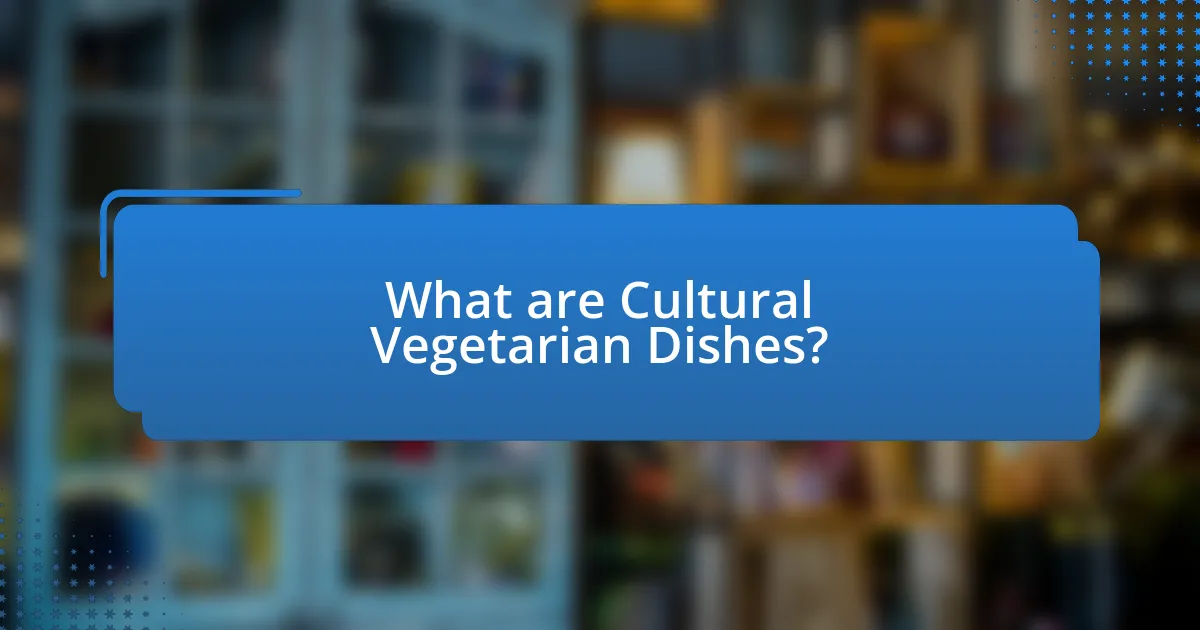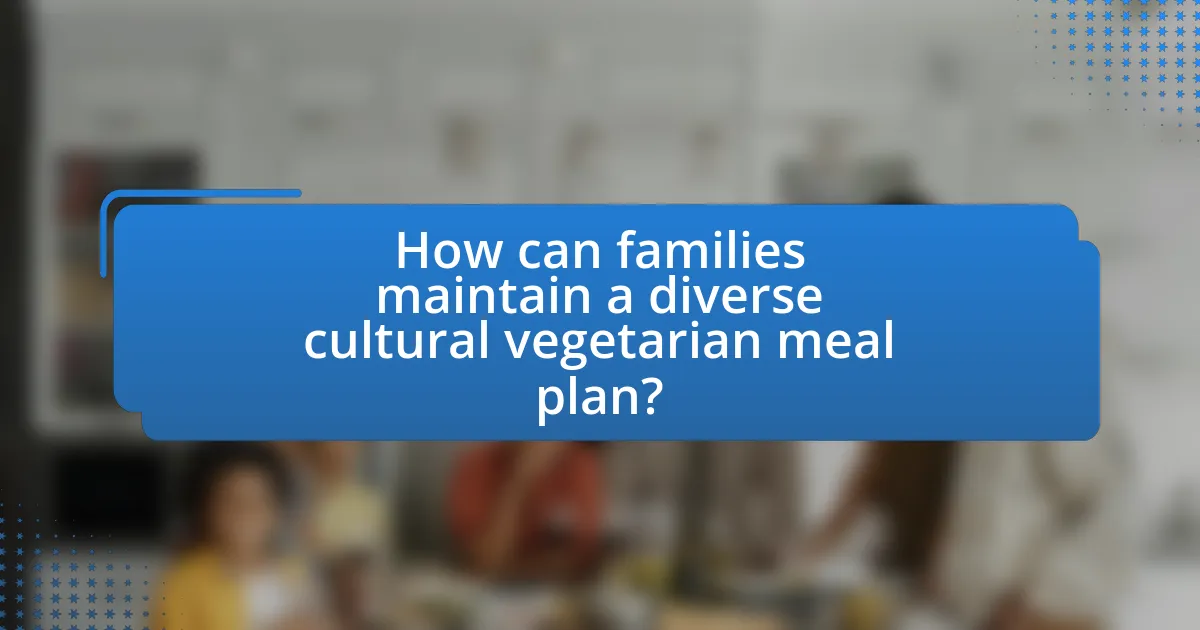Cultural vegetarian dishes are traditional meals from various cultures that exclude meat and fish, showcasing local ingredients and culinary practices. This article explores the diversity of these dishes across different regions, highlighting popular examples such as Indian dal, Italian risotto, and Middle Eastern falafel. It discusses the health benefits of incorporating these meals into family diets, the importance of cultural appreciation, and strategies for overcoming challenges related to ingredient availability and cooking techniques. Additionally, it provides practical tips for families to successfully integrate cultural vegetarian dishes into their meals, fostering a diverse and nutritious diet while enhancing family bonding and cultural understanding.

What are Cultural Vegetarian Dishes?
Cultural vegetarian dishes are traditional meals from various cultures that do not include meat or fish, often highlighting local ingredients and culinary practices. Examples include Indian dal, which is a lentil-based dish rich in protein, and Italian risotto, typically made with rice and vegetables. These dishes often reflect the dietary customs and religious practices of the cultures they originate from, such as Hinduism’s emphasis on vegetarianism. The diversity in flavors and preparation methods showcases the global appreciation for plant-based cuisine, making cultural vegetarian dishes a significant part of culinary heritage.
How do cultural vegetarian dishes vary across different regions?
Cultural vegetarian dishes vary significantly across different regions due to local ingredients, traditions, and culinary practices. For instance, in India, vegetarian cuisine is heavily influenced by religious beliefs, leading to a wide variety of lentil-based dishes like dal and vegetable curries, often accompanied by rice or flatbreads. In contrast, Mediterranean regions emphasize fresh vegetables, legumes, and grains, with dishes such as Greek salad and hummus being staples. In East Asia, particularly in China, vegetarian dishes often incorporate tofu and a variety of vegetables, with stir-frying techniques being common. These regional variations reflect not only the availability of ingredients but also cultural significance, as seen in the use of specific spices and cooking methods unique to each area.
What are some examples of popular cultural vegetarian dishes from around the world?
Popular cultural vegetarian dishes from around the world include Indian Chana Masala, Italian Caprese Salad, Mexican Enchiladas with cheese and beans, Middle Eastern Falafel, and Thai Green Curry with tofu. Chana Masala, a spiced chickpea dish, is a staple in Indian cuisine, showcasing the use of legumes. Caprese Salad features fresh mozzarella, tomatoes, and basil, representing Italian culinary simplicity. Enchiladas are often filled with cheese and beans, highlighting the use of corn tortillas in Mexican culture. Falafel, made from ground chickpeas, is a popular street food in the Middle East. Thai Green Curry incorporates tofu and a variety of vegetables, emphasizing the balance of flavors in Thai cooking. These dishes reflect the diverse ingredients and cooking techniques found in vegetarian cuisines globally.
How do cultural influences shape the ingredients used in vegetarian dishes?
Cultural influences significantly shape the ingredients used in vegetarian dishes by dictating regional preferences, available produce, and traditional cooking methods. For instance, Indian vegetarian cuisine prominently features lentils, spices, and vegetables due to the country’s agricultural practices and religious beliefs that promote vegetarianism. Similarly, Mediterranean diets incorporate ingredients like olives, tomatoes, and legumes, reflecting the climate and agricultural history of the region. These cultural contexts not only determine the types of ingredients used but also influence flavor profiles and preparation techniques, as seen in the use of herbs and spices in Thai vegetarian dishes, which are integral to the cuisine’s identity.
Why is it important to incorporate cultural vegetarian dishes into family meals?
Incorporating cultural vegetarian dishes into family meals is important because it promotes diversity in dietary habits and fosters cultural appreciation. By including these dishes, families can experience a variety of flavors and cooking techniques that reflect different cultural backgrounds. Research indicates that exposure to diverse cuisines can enhance children’s openness to new foods, which is crucial for developing healthy eating habits. Additionally, cultural vegetarian dishes often emphasize plant-based ingredients, contributing to improved nutrition and health outcomes, as studies show that vegetarian diets can lower the risk of chronic diseases.
What health benefits do cultural vegetarian dishes provide?
Cultural vegetarian dishes provide numerous health benefits, including improved heart health, weight management, and enhanced nutrient intake. These dishes often emphasize whole foods, such as fruits, vegetables, legumes, and grains, which are rich in fiber, vitamins, and minerals. For instance, a study published in the Journal of the American College of Cardiology found that plant-based diets can lower the risk of heart disease by reducing cholesterol levels and blood pressure. Additionally, vegetarian diets are associated with lower body mass indexes (BMIs) and reduced obesity rates, as evidenced by research from the American Journal of Clinical Nutrition, which indicates that individuals following vegetarian diets tend to consume fewer calories and higher amounts of dietary fiber. Overall, cultural vegetarian dishes contribute to a balanced diet that supports long-term health.
How can cultural vegetarian dishes promote family bonding and cultural appreciation?
Cultural vegetarian dishes promote family bonding and cultural appreciation by providing shared experiences that foster communication and connection among family members. When families prepare and enjoy these dishes together, they engage in meaningful conversations about their heritage, traditions, and the significance of the ingredients used. For instance, a study published in the Journal of Family Psychology found that shared meals enhance family cohesion and communication, leading to stronger relationships. Additionally, exploring diverse vegetarian recipes allows families to appreciate different cultures, broadening their culinary horizons and understanding of global traditions. This engagement not only strengthens familial ties but also cultivates respect and appreciation for cultural diversity.
What challenges might families face when incorporating cultural vegetarian dishes?
Families may face several challenges when incorporating cultural vegetarian dishes, including ingredient availability, differing taste preferences, and cooking skills. Ingredient availability can be a significant barrier, as specific cultural dishes often require unique ingredients that may not be readily accessible in local grocery stores. Differing taste preferences among family members can lead to resistance or reluctance to try new dishes, particularly if they are accustomed to traditional meat-based meals. Additionally, families may lack the necessary cooking skills or knowledge to prepare these dishes authentically, which can result in frustration or subpar meals. These challenges highlight the complexities involved in integrating cultural vegetarian cuisine into family meals.
How can families overcome ingredient availability issues?
Families can overcome ingredient availability issues by utilizing local substitutes and seasonal produce. By researching alternative ingredients that are culturally relevant, families can adapt traditional vegetarian recipes to include locally sourced items. For instance, if a specific vegetable is unavailable, families can replace it with a similar one that offers comparable taste and texture, ensuring the dish remains authentic. Additionally, seasonal produce often provides fresher options and can be more affordable, allowing families to maintain a diverse and culturally rich diet while addressing availability challenges.
What strategies can help with cooking techniques unfamiliar to the family?
To help with cooking techniques unfamiliar to the family, one effective strategy is to utilize online cooking tutorials and videos that demonstrate specific techniques visually. These resources provide step-by-step guidance, making it easier for family members to grasp unfamiliar methods. For instance, platforms like YouTube host numerous channels dedicated to cooking, where professional chefs and home cooks share their expertise on various techniques, such as sautéing or steaming vegetables, which are often used in cultural vegetarian dishes. Additionally, engaging in hands-on cooking classes, either in-person or virtual, can enhance understanding and confidence in using new techniques, as participants receive direct feedback and support from instructors. This approach is supported by research indicating that experiential learning significantly improves skill acquisition in culinary practices.
How can families start incorporating cultural vegetarian dishes into their meals?
Families can start incorporating cultural vegetarian dishes into their meals by exploring diverse cuisines and selecting recipes that highlight plant-based ingredients. For instance, families can research traditional vegetarian dishes from various cultures, such as Indian dal, Mediterranean falafel, or Mexican chiles rellenos, which are rich in flavor and nutrition. Engaging in cooking classes or online tutorials can also enhance their culinary skills and understanding of these dishes. Additionally, families can visit local ethnic markets to discover authentic ingredients that are essential for these recipes, thereby enriching their meals with cultural significance and variety.
What resources are available for learning about cultural vegetarian cooking?
Books, online courses, and cooking blogs are valuable resources for learning about cultural vegetarian cooking. Notable books include “Vegetarian Cooking for Everyone” by Deborah Madison, which offers a wide range of recipes from various cultures, and “The Complete Vegetarian Cookbook” by America’s Test Kitchen, which provides tested recipes and cooking techniques. Online platforms like Coursera and Udemy offer courses focused on vegetarian cooking that often include cultural aspects. Additionally, blogs such as “Minimalist Baker” and “Oh She Glows” feature diverse vegetarian recipes inspired by different cuisines, making them accessible for home cooks. These resources collectively provide a comprehensive foundation for anyone interested in exploring cultural vegetarian cooking.

What are some practical tips for incorporating cultural vegetarian dishes into family meals?
To incorporate cultural vegetarian dishes into family meals, start by exploring diverse cuisines such as Indian, Mediterranean, or Mexican, which offer a variety of flavorful vegetarian options. For instance, Indian cuisine features dishes like chana masala and palak paneer, while Mediterranean cuisine includes falafel and stuffed grape leaves.
Next, involve family members in the cooking process to foster interest and appreciation for these dishes. Research shows that children are more likely to try new foods when they participate in meal preparation. Additionally, gradually introduce these dishes by substituting familiar ingredients with cultural ones, such as using lentils instead of meat in spaghetti sauce.
Finally, make meals visually appealing by presenting them in colorful ways, as studies indicate that attractive food presentation can enhance the eating experience and encourage children to try new foods.
How can families plan meals that include cultural vegetarian dishes?
Families can plan meals that include cultural vegetarian dishes by researching traditional recipes from various cultures and adapting them to suit their dietary preferences. For instance, families can explore Indian cuisine, which offers a variety of vegetarian options like lentil dal and vegetable curry, or Mediterranean dishes such as falafel and tabbouleh. Incorporating these dishes not only diversifies the family’s diet but also introduces children to global flavors and cooking techniques. Studies show that exposure to diverse cuisines can enhance children’s culinary skills and cultural awareness, making meal planning an educational experience.
What are some easy recipes to start with?
Some easy recipes to start with include vegetable stir-fry, caprese salad, and lentil soup. Vegetable stir-fry requires minimal ingredients such as bell peppers, broccoli, and soy sauce, making it quick to prepare and rich in nutrients. Caprese salad combines fresh mozzarella, tomatoes, and basil, providing a refreshing dish that is simple to assemble. Lentil soup, made with lentils, carrots, and spices, offers a hearty and nutritious option that can be cooked in one pot. These recipes are not only easy to make but also introduce a variety of flavors and ingredients, aligning with the goal of incorporating cultural vegetarian dishes into family meals.
How can families involve children in the cooking process?
Families can involve children in the cooking process by assigning age-appropriate tasks that engage them in meal preparation. For example, younger children can wash vegetables, while older children can help with chopping or measuring ingredients. This hands-on involvement not only teaches children essential cooking skills but also fosters a sense of responsibility and teamwork within the family. Research indicates that children who participate in cooking are more likely to try new foods and develop healthier eating habits, as noted in a study published in the Journal of Nutrition Education and Behavior, which highlights the positive impact of cooking involvement on children’s dietary choices.
What are the best practices for introducing new dishes to family members?
The best practices for introducing new dishes to family members include gradual exposure, involving family members in the cooking process, and highlighting the cultural significance of the dish. Gradual exposure allows family members to become familiar with new flavors and ingredients without overwhelming them. Involving family members in cooking fosters a sense of ownership and curiosity about the dish. Highlighting cultural significance can enhance appreciation and interest, as studies show that understanding the background of a dish can increase willingness to try it. For example, sharing stories about the dish’s origin can create a connection that encourages tasting.
How can families encourage open-mindedness towards trying new foods?
Families can encourage open-mindedness towards trying new foods by involving all members in the meal preparation process. Engaging children and adults in cooking allows them to explore different ingredients and cuisines, fostering curiosity and acceptance of diverse flavors. Research indicates that children who participate in cooking are more likely to try new foods, as they develop a sense of ownership and interest in the meals they help create. For instance, a study published in the Journal of Nutrition Education and Behavior found that children who were involved in food preparation were more willing to taste unfamiliar foods, highlighting the effectiveness of hands-on experiences in promoting open-mindedness towards new culinary experiences.
What role does presentation play in making cultural vegetarian dishes appealing?
Presentation plays a crucial role in making cultural vegetarian dishes appealing by enhancing visual appeal and stimulating appetite. A well-presented dish can evoke cultural significance and tradition, making it more inviting to diners. For instance, vibrant colors, artistic plating, and the use of traditional serving ware can create a sensory experience that highlights the dish’s cultural roots. Research indicates that visually appealing food can increase perceived taste and enjoyment, as demonstrated in studies where participants rated dishes higher when they were attractively presented. This suggests that effective presentation not only showcases the dish’s ingredients but also connects diners to the cultural context, thereby increasing overall appeal.

How can families maintain a diverse cultural vegetarian meal plan?
Families can maintain a diverse cultural vegetarian meal plan by exploring and incorporating recipes from various cuisines around the world. This approach allows families to experience different flavors and cooking techniques, enhancing their meals with cultural significance. For instance, families can include Indian dishes like chana masala, Mediterranean options such as falafel, and Mexican meals like vegetable enchiladas. Research indicates that exposure to diverse cuisines can improve dietary variety and nutritional intake, as highlighted in a study published in the Journal of Nutrition Education and Behavior, which emphasizes the benefits of cultural diversity in meal planning. By regularly rotating these recipes and involving family members in meal preparation, families can create an engaging and educational cooking experience that celebrates cultural diversity while adhering to vegetarian principles.
What strategies can help families rotate cultural vegetarian dishes regularly?
Families can rotate cultural vegetarian dishes regularly by planning a diverse meal calendar that includes recipes from various cultures. This strategy encourages exploration of different cuisines and ensures that meals remain interesting and varied. For instance, dedicating specific days of the week to different cultural themes, such as “Italian Meatless Mondays” or “Indian Vegetarian Wednesdays,” can help families systematically incorporate a range of flavors and ingredients. Additionally, families can involve all members in selecting recipes from cookbooks or online resources, fostering engagement and excitement around meal preparation. Research indicates that involving children in meal planning increases their willingness to try new foods, which can enhance the overall dining experience.
How can families explore new cultures through their vegetarian meals?
Families can explore new cultures through their vegetarian meals by incorporating traditional vegetarian recipes from various cuisines around the world. For instance, families can prepare Indian dishes like chana masala, which features chickpeas and spices, or Italian pasta primavera, highlighting seasonal vegetables. These recipes not only introduce families to diverse flavors and cooking techniques but also provide insights into the cultural significance of the ingredients used. Research indicates that engaging with different culinary traditions can enhance cultural awareness and appreciation, fostering a deeper understanding of global diversity.
What are some seasonal considerations for cultural vegetarian cooking?
Seasonal considerations for cultural vegetarian cooking include selecting ingredients that are at their peak freshness and flavor during specific times of the year. For instance, spring is ideal for incorporating fresh greens and herbs, while summer offers an abundance of vegetables like tomatoes and zucchini. Autumn is perfect for root vegetables and squashes, and winter often calls for hearty grains and legumes. Utilizing seasonal produce not only enhances the taste and nutritional value of dishes but also supports local agriculture and reduces environmental impact. Research shows that seasonal eating can lead to a more sustainable food system, as highlighted in studies by the Food and Agriculture Organization, which emphasize the benefits of consuming locally sourced foods.
What are some common misconceptions about cultural vegetarian dishes?
Common misconceptions about cultural vegetarian dishes include the belief that they lack flavor, are nutritionally inadequate, and are only suitable for specific cultures. Many assume that vegetarian dishes are bland, but numerous cultures, such as Indian and Thai, utilize a variety of spices and cooking techniques to create vibrant flavors. Additionally, some people think vegetarian meals do not provide sufficient protein or essential nutrients; however, many traditional vegetarian dishes incorporate legumes, grains, and vegetables that offer complete nutrition. Lastly, the idea that vegetarian cuisine is exclusive to certain cultures overlooks the global diversity of vegetarian dishes, as many cultures have rich vegetarian traditions, such as Mediterranean, Ethiopian, and Chinese cuisines.
How can families educate themselves and others about the diversity of vegetarian cuisine?
Families can educate themselves and others about the diversity of vegetarian cuisine by exploring various cultural dishes and incorporating them into their meals. Engaging in cooking classes focused on vegetarian recipes from different cultures, such as Indian, Mediterranean, or Asian cuisines, allows families to learn about unique ingredients and cooking techniques. Additionally, families can utilize resources like cookbooks and online platforms that showcase vegetarian dishes from around the world, providing a broader understanding of flavors and traditions. Research indicates that exposure to diverse cuisines can enhance culinary skills and foster appreciation for different cultures, making it an effective method for education.
What resources can help dispel myths about vegetarian diets?
Resources that can help dispel myths about vegetarian diets include scientific studies, reputable health organizations, and educational websites. For instance, the Academy of Nutrition and Dietetics provides evidence-based information that supports the health benefits of vegetarian diets, emphasizing that they can meet nutritional needs at all life stages. Additionally, the Vegetarian Resource Group offers resources that address common misconceptions, such as protein deficiency, by presenting data on plant-based protein sources. These resources are backed by research and expert consensus, making them reliable for educating individuals about the realities of vegetarian diets.
What are some final tips for successfully incorporating cultural vegetarian dishes into family meals?
To successfully incorporate cultural vegetarian dishes into family meals, start by selecting recipes that resonate with your family’s tastes and preferences. Engaging family members in the cooking process can enhance their interest and acceptance of new dishes. Additionally, gradually introducing these dishes alongside familiar favorites can ease the transition. Research shows that involving children in meal preparation increases their willingness to try new foods, as noted in a study published in the Journal of Nutrition Education and Behavior. Lastly, sharing the cultural significance of the dishes can foster appreciation and curiosity, making the meals more enjoyable for everyone.


